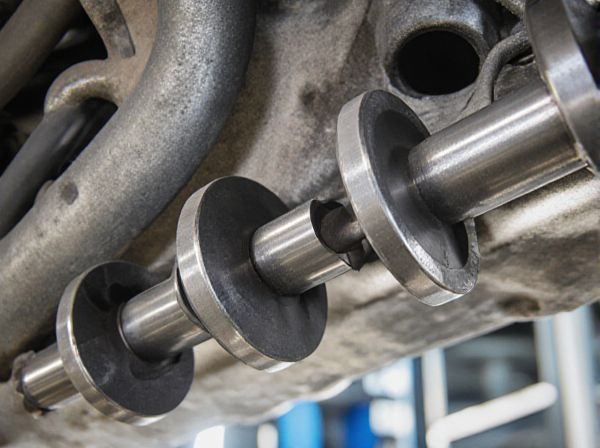
Photo illustration: Flat-plane vs Cross-plane Crankshaft
Flat-plane crankshafts offer quicker revving and a more aggressive exhaust note due to their 180-degree crank angle, often preferred in high-performance sports cars for improved throttle response. Cross-plane crankshafts, with their 90-degree crank throws, provide smoother engine operation and better low-end torque, making them ideal for traditional V8 engines focused on comfort and drivability. Your choice depends on whether you prioritize high-rev performance and sharp sound or smooth power delivery and refinement.
Table of Comparison
| Feature | Flat-Plane Crankshaft | Cross-Plane Crankshaft |
|---|---|---|
| Design | All crank pins lie in the same plane, 180deg between throws | Crank pins arranged at 90deg angles, forming a cross shape |
| Engine Type | Commonly used in high-performance inline-4 and V8 engines | Predominantly used in American V8 engines |
| Vibration | Higher vibration due to lower primary and secondary balance | Smoother operation with better balance characteristics |
| Sound | Distinctive, sharp exhaust note with higher frequency | Deep, rumbling exhaust sound typical of muscle cars |
| Performance | Improved high-RPM power and faster throttle response | Better low-end torque and smoother power delivery |
| Weight | Lighter crankshaft, reduced rotating mass | Heavier due to counterweights for vibration control |
| Manufacturing Complexity | Requires precise balancing, simpler shape | More complex shape with added counterweights |
Introduction to Crankshaft Designs
Flat-plane crankshafts feature crank pins positioned at 180-degree intervals, offering reduced rotational mass and enabling higher engine revs, commonly found in high-performance sports cars. Cross-plane crankshafts have pins arranged at 90-degree angles, providing smoother power delivery and reduced vibration, typically used in V8 engines for balanced torque output. Understanding these designs highlights the trade-offs between engine responsiveness and refinement.
What is a Flat-plane Crankshaft?
A flat-plane crankshaft features crankpins positioned at 180-degree intervals, creating a straight line across the crankshaft. This design reduces rotational inertia, allowing for quicker engine revving and a more responsive throttle feel, commonly found in high-performance sports cars and motorcycles. Its simpler construction compared to cross-plane crankshafts also results in lighter weight and increased engine efficiency.
What is a Cross-plane Crankshaft?
A cross-plane crankshaft features crank pins positioned at 90-degree intervals, creating an uneven firing order that enhances torque delivery and sound quality. This design reduces vibration and improves engine balance, commonly used in V8 engines for smoother performance. Cross-plane crankshafts optimize power output and contribute to characteristic exhaust notes, making them popular in high-performance and muscle car engines.
Historical Development and Origins
Flat-plane crankshafts originated in early racing and sports cars, particularly in European manufacturers like Ferrari and Lotus during the mid-20th century, prized for reducing engine weight and enabling higher RPMs. Cross-plane crankshafts emerged prominently with American V8 engines in the 1930s, designed to improve smoothness and reduce vibrations through better primary balance. The distinct historical paths reflect differing engineering priorities: flat-plane designs optimized for performance and responsiveness, while cross-plane layouts targeted refinement and durability in mass-produced engines.
Key Structural Differences
Flat-plane crankshafts feature a 180-degree crank throw arrangement, creating a linear firing order commonly used in high-revving engines like those in sports cars and motorcycles. Cross-plane crankshafts have a 90-degree crank throw configuration, resulting in a more balanced engine with reduced vibrations, typically found in V8 engines. The flat-plane design is lighter and offers quicker throttle response, while the cross-plane design provides smoother operation and improved low-end torque.
Performance and Power Characteristics
Flat-plane crankshafts deliver higher revving capabilities and sharper throttle response due to their reduced rotational inertia, making them ideal for high-performance sports cars seeking peak power at elevated RPMs. Cross-plane crankshafts provide smoother power delivery and better torque at lower RPMs, favored in muscle cars and V8 engines for their balanced firing order and reduced vibration. The choice between flat-plane and cross-plane crankshafts significantly influences engine sound, power curve, and overall driving dynamics.
Engine Sound and Vibration Comparison
Flat-plane crankshafts produce a sharper, higher-pitched exhaust note due to their even firing intervals and reduced rotational inertia, often favored in performance sports cars for their aggressive engine sound. Cross-plane crankshafts generate a deeper, rumbling sound with uneven firing intervals, which creates distinctive vibrations that are typically smoother in low RPM ranges, common in V8 muscle cars. Vibrational characteristics differ as flat-plane setups exhibit more high-frequency vibrations and less inertia, while cross-plane designs provide better balance and reduced engine harshness, impacting the overall driving experience and acoustic signature.
Applications in Modern Engines
Flat-plane crankshafts, commonly used in high-performance sports cars such as the Ferrari 458 Italia, offer rapid engine response and higher RPM capabilities due to their balanced firing order. Cross-plane crankshafts dominate in American V8 muscle cars like the Ford Mustang GT, providing smoother operation and reduced vibration for enhanced drivability. Modern engine applications leverage flat-plane designs for their lightweight and performance advantages in racing and supercars, while cross-plane configurations remain preferred in everyday vehicles for their durability and refinement.
Pros and Cons of Each Crankshaft Type
Flat-plane crankshafts offer higher revving capabilities and reduced rotational inertia, resulting in quicker throttle response and improved engine efficiency. However, they tend to generate more vibration and less smoothness, which can affect ride comfort and long-term durability. Cross-plane crankshafts provide superior engine balance and smoother operation, reducing vibration and enhancing reliability, but they have higher rotational mass that limits rev speed and slightly decreases throttle responsiveness.
Choosing the Right Crankshaft for Your Engine
Flat-plane crankshafts offer quicker throttle response and higher revving capabilities, making them ideal for lightweight, high-performance engines focused on precision and agility. Cross-plane crankshafts provide smoother power delivery and reduced vibrations, enhancing comfort and durability in heavier, torque-oriented engines. Selecting the right crankshaft depends on your engine's intended use, balancing performance goals with vibration management and operational smoothness.
 caratoz.com
caratoz.com